Appel W. Mathematics for Physics and Physicists
Подождите немного. Документ загружается.


Exterior algebra 467
that is, when no ambiguity a rises, repeated indices (appearing once as super-
script and once as subs cript) are assumed to be summed in strict ly increasing
order; so if there are k indices, the sum is over
n
k
terms instead of n
k
terms.
For the s pecial case k = n, we deduce the following result:
THEOREM 17.16 The space Λ
∗n
(R
n
) is of dimension 1.
COROLLARY 17.1 6.1 Any exterior n-form on R
n
is a multiple of the form “deter-
minant in the canonical basis.”
DEFINITION 17.17 A volume form on R
n
is any nonzero exterior n-form.
Remark 17.18 We wi ll often denote ω
k
an exterior k-form, ω
p
an exterior p-form,
and so on. This supscript notation is only intended to recall the “degree” of the form
which is considered. In particular, it should not be mistaken wit h the exponent in a
power expression.
17.1.d Exterior product
There is a product defined on the various spaces of exterior forms, which
associates a (k+ℓ)-exterior form ω
k
∧ω
ℓ
to a pair (ω
k
, ω
ℓ
) in Λ
∗k
(E)×Λ
∗ℓ
(E).
We will first give the definition for the product of two 1-forms, then generalize
it. Note that the notation will be consistent with the prev ious introduction
of basis elements dx
i
1
∧···∧ dx
i
k
for Λ
∗k
(E) (i.e., th ose will be products of
1-forms).
Exterior product of two 1-forms
DEFINITION 17.19 Let ω, ω
′
be exterior 1-forms. The exterior product ω ∧
ω
′
of ω and ω
′
is defined by
ω ∧ω
′
def
= (ω ⊗ ω
′
−ω
′
⊗ω).
It is easily ch ecked that ω ∧ω
′
is an exterior 2-form.
PROPOSITION 17.20 Let ω and ω
′
be e xterior 1-forms. Then we ha ve
(ω ∧ω
′
)( x, y) =
ω( x) ω
′
( x)
ω( y) ω
′
( y)
,
and moreover ω∧ω
′
= −ω
′
∧ω. The exterior product is bilinear and antisymmetric.
Similarly, the product of p exterior 1-forms may be defined as follows:
DEFINITION 17.21 Let ω
1
, . . . , ω
p
be exterior 1-forms. Then the exterior
product ω
1
∧ ··· ∧ ω
p
∈ Λ
∗p
(E) is defined as the multilinear map on E
p
468 Differen tial forms
such that
ω
1
∧···∧ ω
p
( x
1
, . . . , x
p
)
def
=
ω
1
( x
1
) . . . ω
p
( x
1
)
.
.
.
.
.
.
ω
1
( x
p
) . . . ω
p
( x
p
)
.
Exterior product of two arbitrary exterior forms
We now introduce the general definition of the exterior product of two exte-
rior forms.
DEFINITION 17.22 (Exterior product) Let k, ℓ ∈ N
∗
, ω
k
∈ Λ
∗k
(E) and ω
ℓ
∈
Λ
∗ℓ
(E). The exterior product of ω
k
and ω
ℓ
is the exterior (k + ℓ)-form
denoted ω
k
∧ω
ℓ
such that
ω
k
∧ω
ℓ
( x
1
, . . . , x
k+ℓ
)
def
=
X
σ∈S
k+ℓ
ǫ(σ) ω
k
( x
σ(1)
, . . . , x
σ(k)
)
·ω
ℓ
( x
σ(k+1)
, . . . , x
σ(k+ℓ)
).
Example 17.23 For a 2-form ω
2
and a 1-form ω
1
, we have
ω
2
∧ω
1
(a, b , c) = 2ω
2
(a, b ) ω
1
(c) + 2ω
2
(b, c) ω
1
(a) + 2ω
2
(c, a) ω
1
(b).
The reader is invited, as an exercise, to check the following result:
PROPOSITION 17.24 The exterior product is
• (anti)symmetric: ω
p
∧ ω
q
= (−1)
pq
ω
q
∧ ω
p
for ω
p
∈ Λ
∗p
(E) and
ω
q
∈ Λ
∗q
(E);
• distributive with respect to addition: ω ∧(ω
′
+ ω
′′
) = ω ∧ω
′
+ ω ∧ω
′′
;
• associative: (ω ∧ω
′
) ∧ω
′′
= ω ∧(ω
′
∧ω
′′
).
Example 17.25 Let ω and ω
′
be exterior 1-forms. Then using Definition 17.22 we get
ω ∧ ω
′
( x, y) = ω( x) ω
′
( y) −ω
′
( x) ω( y),
i.e. ω ∧ω
′
= ω ⊗ω
′
−ω
′
⊗ω as defined in the preceding paragraph.
PROPOSITION 17.26 Let ω
1
, . . . , ω
p
, ω
p+1
, . . . , ω
p+q
be exter ior 1-forms. Th en
we have
(ω
1
∧···∧ω
p
) ∧(ω
p+1
∧···∧ω
p+q
) = ω
1
∧···∧ω
p
∧ω
p+1
∧···∧ω
p+q
.
Proof. This formula follows from the definition of the exterior product of 1-forms
and the compatibility with t h e general definition.

Differential forms on a vector space 469
DEFINITION 17.27 The e xterior algebra on R
n
is the vector space
Λ
∗
(R
n
)
def
=
n
M
k=0
Λ
∗k
(R
n
).
The exterior product is extended to the exterior algebra by distributivity.
17.2
Differential forms on a vector space
17.2.a Definition
As before, in all this section, E = R
n
is a real vector space of finite dimen-
sion n.
DEFINITION 17.28 Let p be an integer or +∞. A differential form of
degree k on RR
R
R
RR
n
of CC
C
C
CC
p
-class, or differential k-form, is a map of C
p
-class
ω : R
n
−→ Λ
∗k
(R
n
),
x 7−→ ω( x).
For any point x in R
n
, ω( x) is therefore an exterior k-form on R
n
.
What is the precise meaning of “C
p
-class” here? Any differential k-form
may be written
ω( x) = ω
i
1
,...,i
k
( x) dx
i
1
∧···∧dx
i
k
,
where x 7→ ω
i
1
,...,i
k
( x) are real-valued functions on R
n
. Then x 7→ ω( x) is
of C
p
-class if and only if the
n
k
functions x 7→ ω
i
1
,...,i
k
( x) are.
Before going farther, here are some examples of differential k-forms, with
E = R
n
.
• For k = 0: a differential form of degree 0 is none ot her than a function
on E, of C
p
-class, with values in R.
• For k = 1: let ω
1
be a dif ferential 1-form. Then there exists an n-tuple
( f
1
, . . . , f
n
) of functions of C
p
-class such that
ω
1
= f
1
dx
1
+ ···+ f
n
dx
n
.
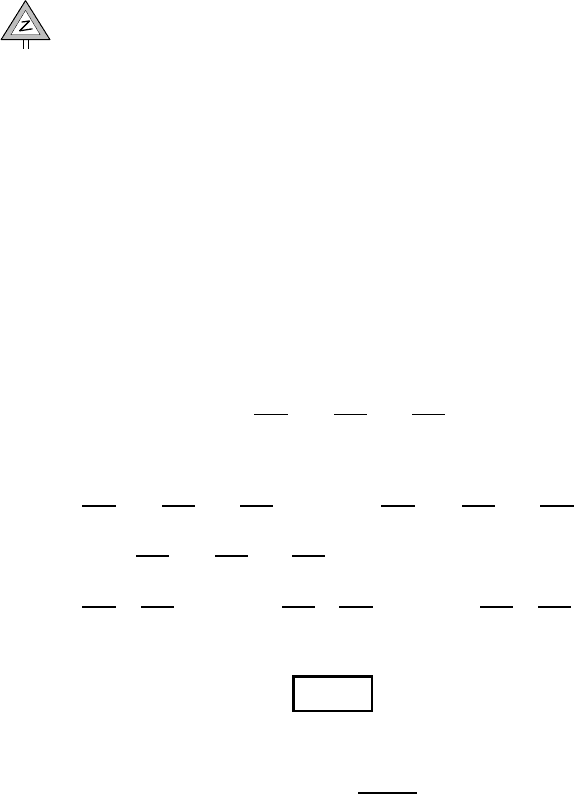
470 Differ en tial forms
• For k = 2: let ω
2
be a d ifferential 2-form. There exist n(n − 1)/2
functions ( f
i j
)
1¶i< j¶n
(of C
p
-class) such that
ω
2
= f
12
dx
1
∧dx
2
+ f
13
dx
1
∧dx
3
+ ···+ f
1n
dx
1
∧dx
n
+ ···+ f
n−1,n
dx
n−1
∧dx
n
=
X
1¶i< j¶n
f
i j
dx
i
∧dx
j
= f
i j
dx
i
∧dx
j
.
Note again the use of the convention of partial summation of repeated
indices.
Remark 17.29 Warning: in what follows, as in most books, the point x in space
where the extorior form is e valuated will be omitted from the notation, and we will
often write ω instead of ω( x), when no ambiguity exists. Thus, for a 2-form ω,
ω(ξξ
ξ
ξ
ξξ
1
,ξξ
ξ
ξ
ξξ
2
) will be the real number obtained by applying the exterior 2-form ω( x) to
the vectors ξξ
ξ
ξ
ξξ
1
and ξξ
ξ
ξ
ξξ
2
in E.
17.2.b Exterior derivative
DEFINITION 17.30 Let ω = ω
i
1
,...,i
k
( x) dx
i
1
∧ ···∧ dx
i
k
be a differential k-
form. Since the functions x 7→ ω
i
1
,...,i
k
( x) are differentiable, the differentials
dω
i
1
,...,i
k
( x) are exterior 1-forms. The exterior derivative of the k-form ω is
the differential form of degree k + 1 given by
dω = dω
i
1
,...,i
k
( x) ∧dx
i
1
∧···∧ dx
i
k
.
Example 17.31 Let ω = ω
x
dx + ω
y
dy + ω
z
dz be a differential 1-form on R
3
. Then we have
dω
x
=
∂ω
x
∂ x
dx +
∂ω
x
∂ y
dy +
∂ω
x
∂ z
dz,
and similarly for dω
y
and dω
z
. It follows that
dω =
∂ω
x
∂ x
dx +
∂ω
x
∂ y
dy +
∂ω
x
∂ z
dz
∧dx +
∂ω
y
∂ x
dx +
∂ω
y
∂ y
dy +
∂ω
y
∂ z
dz
∧dy
+
∂ω
z
∂ x
dx +
∂ω
z
∂ y
dy +
∂ω
z
∂ z
dz
∧dz
=
∂ω
y
∂ x
−
∂ω
x
∂ y
dx ∧dy +
∂ω
z
∂ y
−
∂ω
y
∂ z
dy ∧dz +
∂ω
x
∂ z
−
∂ω
z
∂ x
dz ∧dx.
THEOREM 17.32 Let ω be a differential k-form of c lass at least C
2
. Then ddω ≡
0, in other words we have identically d
2
≡ 0.
Proof. We have by definition dω = dω
i
1
,...,i
k
( x) ∧dx
i
1
∧··· ∧dx
i
k
, with
dω
i
1
,...,i
k
=
∂ω
i
1
,...,i
k
∂ x
α
dx
α
.
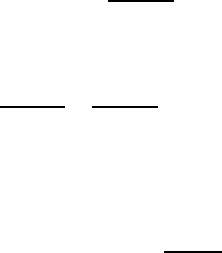
Integration of differential forms 471
It follows that
ddω =
∂
2
ω
i
1
,...,i
k
∂ x
β
∂ x
α
dx
β
∧dx
α
∧dx
i
1
∧··· ∧dx
i
k
.
But since the form ω is of C
2
-class, Schwarz’s theorem on the commutativity of second
partial derivatives implies t h at
∂
2
ω
i
1
,...,i
k
∂ x
β
∂ x
α
=
∂
2
ω
i
1
,...,i
k
∂ x
α
∂ x
β
and dx
α
∧dx
β
= −dx
β
∧dx
α
,
which shows that the preceding expression is identically zero.
17.3
Integration of differential forms
The general theory of integration of d ifferential forms is outside the scope
of this book. Hence the results we present a re only intended to give an
idea of the flavor of this subject. The interested reader can turn for more
details to a book of differential geometry such as Carta n [17], Nakahara [68],
or Arnold [9]. Before discussing the general case, we mention two special
situations: the integration of n-forms on R
n
and of 1-forms on any R
n
.
DEFINITION 17.33 (Integral of a differential n-form) Let Ω be a sufficiently
regular domain in R
n
(so Ω is an n-dimensional “volume”) and let ω be a
differential n-form. Then there exists a function f such that we can wr ite
ω( x) = f ( x) dx
1
∧···∧dx
n
,
and the integral of ω on Ω is defined to be
Z
Ω
ω
def
=
Z
Ω
f ( x) dx
1
···dx
n
.
Be careful that this special case of integration of forms of degree n on a
space of the s ame dimension is indeed very special.
The next special case is that of differential 1-forms. Before trying to in-
tegrate a 1-form ω on a domain, we must look again at what is the nature
of ω. At a point x ∈ R
n
, the value ω( x) of ω is an exterior 1-form, that
is, simply a linear form which as sociates a real number to a vector. Where
may we naturally find vectors? In differential geometry, vectors are defined in
the same manner that velocity vectors are defined in physics: one chooses a
curve t 7→ γγ
γ
γ
γγ(t) going t hrough x and one looks a t what is t he “velocity” of
the moving point γγ
γ
γ
γγ(t) when it passes at the point x.
So, consider a path γγ
γ
γ
γγ : [0, 1] → R
n
, t 7→ γγ
γ
γ
γγ(t). Then for any t ∈ [0, 1],
the velocity vector γγ
γ
γ
γγ
′
(t) = dγγ
γ
γ
γγ/dt provides, after being “fed” to ω
γγ
γ
γ
γγ(t)
(the
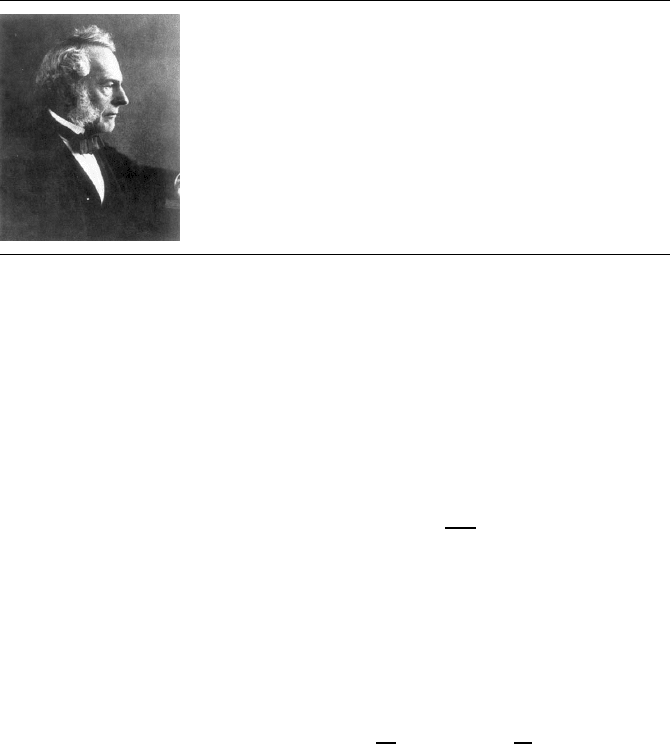
472 Differential forms
George Stokes (1819—1903), English p hysi cist and mathematician,
discovered the concept of uniform convergence, but his most impor-
tant contributions were in physics, in partic u l ar in fluid mechan-
ics, where he investigated the differential equations introduced by
Navier that now bear their names. The formula linking the circu-
lation of a vector field and the flux of its curl is also due to him.
exterior form given by evaluating ω at the point γγ
γ
γ
γγ(t)) a real number, namely,
g(t) = ω
γγ
γ
γ
γγ(t)
γγ
γ
γ
γγ
′
(t)
; this real number may be integrated along the path,
and the resulting integral will give the definition of the integral of ω on the
path γγ
γ
γ
γγ:
DEFINITION 17.34 (Integral of a differential 1-form on a path)
Let γγ
γ
γ
γγ be a path and ω = f
i
dx
i
a differential 1-form. T he integral of ω on γγ
γ
γ
γγ
is defined as the integral
Z
γγ
γγ
γγ
ω =
Z
γγ
γγ
γγ
f
i
dx
i
=
Z
1
0
f
i
γγ
γ
γ
γγ(t)
dx
i
dt
dt,
where the path is parameterized by
γγ
γ
γ
γγ : [0, 1] −→ R
n
,
t 7−→ γγ
γ
γ
γγ(t) =
x
1
(t), . . . , x
n
(t)
.
Example 17.35 In the plane R
2
, with ω = f dx + g dy, we obtain
Z
γ
ω =
Z
γ
f dx + g dy =
Z
γ
f
γ(s)
dx
ds
ds +
Z
γ
g
γ(s)
dy
ds
ds.
This recovers the notion already seen (in complex analysis) of contour integration.
In the general case, h ow do we integrate a differential k- form? Most impor-
tantly, on what domain should one perform such an integral? Take a 2-form,
for instance. At every point of this integration domain, we need two vectors.
This is easily given if this domain is a smooth surface, for t he t wo vectors can
then be a basis of the tangent plane. A differential 2-form must be integrated along
a 2-dimensional surface.
As an example, we consider a 2-form ω
2
in the space R
3
. We denote it
ω = f
x
dy ∧ dz + f
y
dz ∧dx + f
z
dx ∧dy.
(Note that we have changed conventions s omewhat, using dz ∧dx instead of
dx ∧dz; this only amounts to changing the sign of f
y
.) Let S be an oriented

Integration of differential forms 473
surface. At any point x in S , we can perform the orthogonal projection
of th e basis vectors of R
3
to the tangent plane of S at x (this is a linear
operation). Hence three vectors u
x
, u
y
, and u
z
are obtained, attach ed to each
point x ∈ S ; they are not linearly independent since t hey belong to the two-
dimensional tangent plane to the surface. Consider then f
z
dx ∧dy( u
x
, u
y
),
which is a real number. This may be integrated over the whole surface. Note
that dx ∧dy( u
x
, u
y
) = n · e
z
, and therefore we obtain
Z
S
ω
2
=
Z
S
f
x
dy ∧dz + f
y
dz ∧dx + f
z
dx ∧dy
=
Z
S
f
x
dx + f
y
dy + f
z
dz =
Z
S
f · n,
where n is the normal vector to the surface. The first integral involves the
differential form ω, whereas the integral on the second line is an integral of
functions.
This is easy to memorize: it suffices to replace dx ∧dy by dz and, similarly
dy ∧dz by dx and dz ∧dx by dy.
To generalize this result, it is necessary to study the behavior of a differen-
tial form during a change of coordinates. This is done in sidebar 6. One shows
that a differential k-form may be integrated on a “surface” of d imension k,
that is, there appears a duality
2
between
• differential 1-forms and paths (curves);
• differential 2-forms and surfaces;
• differential 3-forms and volumes (of dimension 3) or three-dimensional
surfaces in R
n
;
• etc.
The following result is then particularly interesting:
THEOREM 17.36 (Stokes) Let Ω be a smooth (k + 1)-dimensional domain with k-
dimensional boundary ∂ Ω (possibly empty), and let ω be a differential k-form on E.
Then we have
Z
∂Ω
ω =
Z
Ω
dω.
This formula is associated with many names, including Newton, Leibniz, Gauss, Green,
Ostrogradski, Stokes, and Poincaré, but it is in general called the “Stokes formula.”
Example 17.37 The boundary of a path γ : [0, 1] → R
n
is made of only the points b = γ(1)
and a = γ(0) . Let us consider the case n = 1 and let ω be a differential 0-form, that is, a
2
The following is meant by “duality”: the meeting of a k-form and a k-surface gives a
number, just as the meeting of a linear form and a vector gives a number.
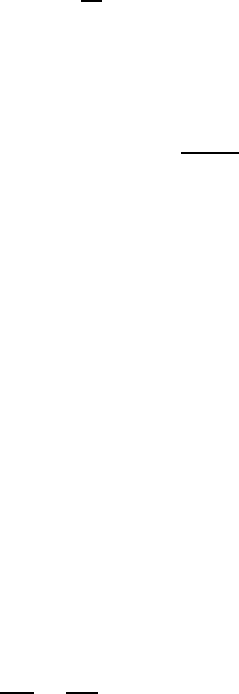
474 Differential forms
function ω = f : R → R. Then the Stokes formula means that we have
Z
γ
d f =
Z
1
0
d f
dt
γ(t)
·γ
′
(t) dt =
Z
b
a
f
′
(s) ds = f (b ) − f (a),
which is of course known to the youngest children.
17.4
Poincar
´
e’s theorem
DEFINITION 17.38 (Exact, closed differential forms) A differential form ω is
closed if dω = 0.
A differential k- form ω is exact if there exists a differential (k − 1)-form
A such that ω = dA.
THEOREM 17.39 Any exact dif ferential form is closed.
Proof. Indeed, if ω is e xact, there exists a form A such that ω = dA, and we then
have dω = ddA = 0.
Note that an exact differential 1-form is none oth er t han a differential (of
a function). Indeed, if ω is an exact differential 1-form, there exists a 0-form,
that is, a function f , such that ω = d f .
THEOREM 17.40 (Schwarz) Let ω be a differential 1-form. If we write ω =
f
i
(x) dx
i
, then the following are equivalent
a) ω is closed (i.e., dω = 0) ;
b) we have
∂ f
i
∂ x
j
=
∂ f
j
∂ x
i
for any i, j ∈ {1, 2, 3}.
Proof. Assume first that ω is closed. Then dω = 0 = ∂
k
f
i
dx
k
∧dx
i
; since dx
k
∧
dx
i
= dx
k
⊗dx
i
−dx
i
⊗dx
k
, this shows that ∂
k
f
i
= ∂
i
f
k
.
Conversely, ∂
k
f
i
= ∂
i
f
k
obviously implies that dω = 0.
Knowing whether the converse to Theorem 17.39 holds, that is, wheth er
any closed form is exact, turns out to be of paramount importance. The
answer depends in a cr ucial way on the shape and structure of the domain of
definition of the differential form.
DEFINITION 17.41 (Contractible open set) A contractible open set in R
n
is
an open subset which may be continuously deformed to a point. Hence, Ω is
contractible if and only if there exists a continuous map C : Ω ×[0, 1] → Ω
and a point p ∈ Ω such that
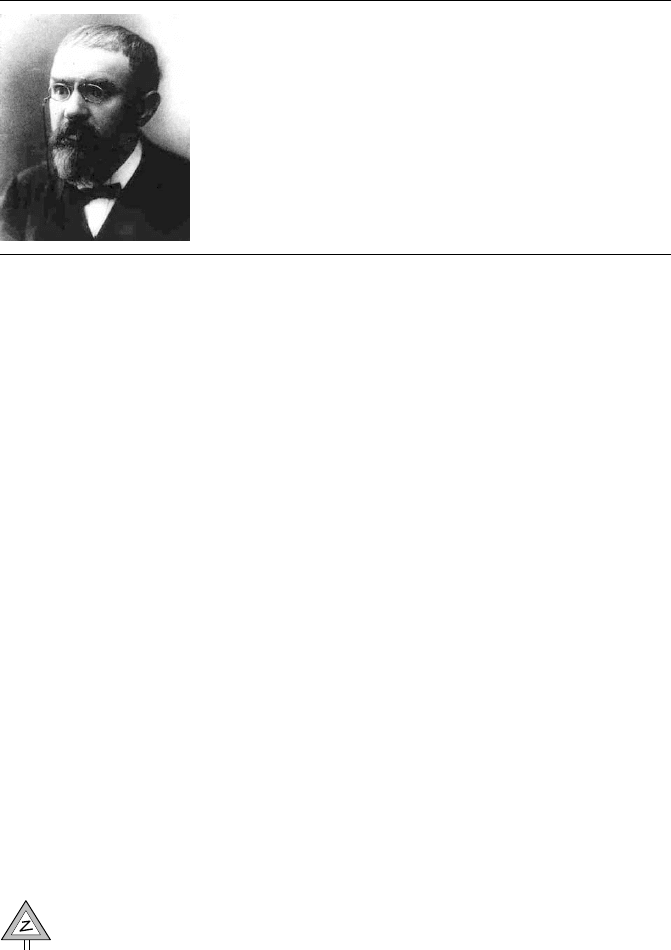
Poincaré’s theorem 475
Henri Poincaré (1 854—1912) is one the most universal geniuses
in the whole history of mathematics; he studied — and often
revolutionized — most areas of the mathematics of his time, and
also mechanics, astronomy, and philosophy. He created topology,
used this new tool to investigate differential equations, flirted
with chaos, studied asymptotic expansions, and proved th at the
time series used in astronomy are of this type. He also gave a
major contribution to the three-body problem.
a) C (x, 0) = x for all x ∈ Ω;
b) C (x, 1) = p for all x ∈ Ω.
Example 17.42 A star-shaped open set is contractible. Here, an open set Ω is star-shaped if
and only if, for any x ∈ Ω, the line segment
[0, x]
def
=
n
λ x ; λ ∈ [0, 1]
o
is contained is Ω. In particular, R
n
is star-shaped and hence contractible. Here we can choose
p = 0 and the map C may be defined by
∀x ∈ R
n
∀θ ∈ [0, 1] C (x, θ) = (1 −θ) x.
Example 17.43 The surface of a torus is not contractible.
R
n
\{0} is not contractible (although it is simply connected as soon as n ¾ 2).
THEOREM 17.44 (Poincar
´
e) Let Ω ⊂ R
n
be a contractible open set in R. Then
any closed differential form on Ω is exact.
In one important special case, a more general condition than contractibil-
ity is sufficient to ensure that a closed form is ex act. Indeed, for differential
1-forms, we have
THEOREM 17.45 Let Ω ⊂ R
n
be a simply connected and connected open set.
Then any closed differential 1-form on Ω is exact.
Remark 17.46 Be careful that this theorem is only valid for differential 1-forms. In
general, it is not sufficient for a closed differential form to be defined on a simply
connected set in order for it to be exact. We will see below (see page 480) a simple
consequence of this for the field created by a magnetic monopole.
Notice that a ny contractible subset is simply connected (it suffices to look
at the image of a path γ under th e “contraction” C to see that it also contracts
to a single point), but the converse is not true.

476 Differential forms
Counterexample 17.47 Consider the differential 1-form
ω =
(x − y) dx + (x + y) dy
x
2
+ y
2
in R
2
. It is easy to check that dω = 0 on R
2
\
(0, 0)
, using Schwarz’s theorem, for instance.
However, ω is not exact. One may indeed integrate ω to get
f (x, y) =
1
2
log(x
2
+ y
2
) −arctan
x
y
+ C
nt
,
but this expression is singular at y = 0 and does not admit any conti nuous continuation
on R
2
\
(0, 0)
. This is possible because R
2
\
(0, 0)
is not simply connected.
17.5
Relations with vector calculus:
gradient, divergence, curl
17.5.a Differential forms in dimension 3
Consider now the case of differential forms in three-dimensional space R
3
.
These are
• the 0-forms, that is, functions;
• the 1-forms, which are linear combinat ions of dx, dy, and dz;
• the 2-forms which are linear combinatons of dx ∧ dy, dy ∧ dz, and
dz ∧dx;
• the forms of degre 3, multiples of the volume form dx ∧ dy ∧dz.
Let ω be a differential 1-form, so that
ω = f
i
dx
i
= f
x
dx + f
y
dy + f
z
dz.
Let now γ be a smooth closed path in R
3
. Then this path bounds an oriented
surface (oriented using the orientation of γ), denoted S . So we have γ = ∂S .
Since the exterior derivative of ω is given by
dω =
∂ f
y
∂ x
−
∂ f
x
∂ y
dx∧dy+
∂ f
z
∂ y
−
∂ f
y
∂ z
dy∧dz+
∂ f
x
∂ z
−
∂ f
z
∂ x
dz∧dx,
Stokes’s formula gives
Z
S
dω =
Z
γ
ω,
